6 X Rasbora maculata – Dwarf Rasbora (Pygmy Rasbora), Stunning Freshwater Fish for Nano Tanks, Ideal for Creating Peaceful Schooling Environments, Perfect Community Companions
£18.99 Original price was: £18.99.£15.99Current price is: £15.99.
Welcome these beautiful 6 X Rasbora maculata, also known as Dwarf Rasboras, to your tropical aquarium. Their stunning colors and graceful movements make them ideal community fish, perfect for beginners. Create a peaceful environment alongside bettas and neon tetras with these vibrant freshwater fish.
Species Introduction
The Dwarf Rasbora, scientifically known as Rasbora maculata, is a captivating species that hails from the tranquil waters of Southeast Asia, particularly in regions such as Thailand and Malaysia. These stunning small freshwater fish are well-regarded for their vibrant colors and peaceful demeanor, making them an ideal choice for aquarists looking to create serene schooling environments. Typically, they thrive in densely vegetated areas of slow-moving streams and rivers, where they find ample cover and food sources. In the wild, they exhibit a preference for soft, slightly acidic waters, which is essential for their overall health and well-being. Understanding their natural habitat is crucial for replicating the conditions they require in a home aquarium, ensuring that these beautiful creatures flourish and exhibit their natural behaviors.
Care Requirements Dashboard
| Optimal Living Conditions | |
|---|---|
| Water Temperature | 24-27°C (75-81°F) |
| pH Level | 6.5-7.5 |
| Water Hardness | 4-12 dKH |
| Minimum Tank Size | 80L (20 gal) |
| Salinity | Freshwater |
| Care Level | Beginner Friendly |
✓ Care Level: Easy
Tank Size: Minimum 10 gallons
Water Parameters: pH 6.0-7.5, Temperature 72°F-82°F (22°C-28°C), Hardness 2-15 dGH
Natural Behavior & Temperament
Dwarf Rasboras are known for their peaceful nature and social behavior, often found swimming in small schools in their natural habitat. This schooling behavior is not only a natural instinct but also a vital part of their well-being, as they feel more secure and less stressed when surrounded by their companions. In an aquarium setting, it is recommended to welcome at least six individuals together to promote natural behaviors and reduce stress. Their swimming patterns are characterized by graceful darting movements and gentle gliding, making them a delightful addition to community tanks. Observing these fish interact with one another can be a rewarding experience, as they engage in playful displays and social hierarchies. Their calm demeanor allows them to coexist harmoniously with other peaceful species such as neon tetras and bettas, contributing to a tranquil aquarium environment.
Tank Setup Guide
Creating an ideal environment for your Dwarf Rasboras involves careful consideration of tank setup and decor. A minimum tank size of 10 gallons is recommended, as it provides ample swimming space and helps maintain stable water parameters. The substrate should be soft and sandy, mimicking their natural habitat, and allowing for easy burrowing if desired. Incorporating plenty of live plants, such as Java moss and Anubias, not only enhances the aesthetic appeal of the tank but also offers hiding spots and grazing areas for these fish. Additionally, driftwood and rock formations can create visual barriers and territories, further enriching the environment. It is essential to ensure that the tank is well-cycled before introducing your Dwarf Rasboras, as stable water quality is crucial for their health. A gentle filter and moderate water movement will help replicate their natural habitat, providing a serene environment for these aquatic companions.
Water Quality Management
Maintaining optimal water quality is paramount for the health and longevity of your Dwarf Rasboras. These fish thrive in slightly acidic to neutral water, with a pH range of 6.0 to 7.5. Regular testing of the water parameters is essential to ensure they remain within this range. The temperature should be kept between 72°F and 82°F (22°C to 28°C), which mimics their natural tropical environment. Additionally, the hardness of the water should be maintained between 2 to 15 dGH, as extreme fluctuations can lead to stress and health issues. Performing regular water changes of 10-20% weekly will help maintain water quality and remove harmful toxins. Utilizing a quality water conditioner can also assist in detoxifying chlorine and heavy metals, ensuring a safe environment for your fish friends. Monitoring ammonia and nitrite levels is crucial, as these compounds can be detrimental to their health. Keeping a close eye on these parameters will help create a thriving habitat for your Dwarf Rasboras.
Feeding & Nutrition
✓ Diet: Omnivorous
Feeding Schedule: 2-3 times daily
Food Types: Flake food, micro-pellets, live or frozen food
Dwarf Rasboras are omnivorous, requiring a balanced diet to thrive. High-quality flake food or micro-pellets should form the base of their diet, supplemented with live or frozen foods such as brine shrimp, daphnia, and bloodworms. This varied diet not only promotes optimal health but also enhances their coloration and vitality. It is recommended to feed them 2-3 times daily, offering only what they can consume within a few minutes to prevent overfeeding and maintain water quality. Observe their feeding behavior, as Dwarf Rasboras are not aggressive eaters and may require encouragement to compete with faster fish. Providing a variety of food types will ensure they receive essential nutrients and keep them active and healthy. Additionally, incorporating plant matter, such as blanched spinach or algae wafers, can further diversify their diet and promote digestive health.
Compatibility Guide
When selecting tank mates for your Dwarf Rasboras, it is essential to choose species that share similar temperaments and environmental requirements. These peaceful fish thrive in community tanks and coexist harmoniously with other gentle species such as neon tetras, guppies, and Corydoras catfish. Avoid housing them with aggressive or larger fish, as this can lead to stress and potential harm. Dwarf Rasboras are ideal companions for other small tropical fish, making them a perfect addition to a community tank setup. It is advisable to introduce them to a well-established aquarium with stable water parameters, allowing them to acclimate gradually. Observing their interactions with other species will help ensure a peaceful environment, as Dwarf Rasboras are known for their non-aggressive nature. By carefully selecting compatible tank mates, you can create a thriving aquatic community that showcases the beauty and diversity of freshwater fish.
Health & Wellness
✓ Common Issues: Ich, fin rot
Prevention: Regular water changes, good tank maintenance
Signs of Health: Active swimming, vibrant coloration
Maintaining the health and wellness of your Dwarf Rasboras is crucial for their longevity and quality of life. Common health issues include ich and fin rot, which can arise from poor water quality or stress. Regular water changes and maintaining stable parameters are key preventive measures. Observing your fish for signs of illness, such as lethargy, loss of appetite, or unusual swimming patterns, is essential for early detection and treatment. When introducing new fish, ensure they are quarantined to prevent the spread of disease. Providing a stress-free environment with plenty of hiding spots and appropriate tank mates can significantly reduce the risk of health issues. In case of illness, prompt treatment with appropriate medications and maintaining optimal water conditions will aid in recovery. By prioritizing their health and wellness, you can ensure your Dwarf Rasboras thrive in a harmonious aquarium setting.
Breeding Information
Breeding Dwarf Rasboras can be a rewarding experience for aquarists. To encourage spawning, it is best to set up a separate breeding tank with soft, slightly acidic water and plenty of fine-leaved plants for the eggs to adhere to. The ideal conditions for breeding include a temperature of around 78°F (25°C) and a pH of 6.0-6.5. Once the breeding pair is established, they will engage in courtship displays, and the female will lay eggs on the plant leaves. After spawning, it is advisable to remove the parents to prevent them from eating the eggs. The eggs will hatch within 24-36 hours, and the fry can be fed infusoria or finely crushed flakes until they are large enough to consume larger foods. Providing a stable environment and proper nutrition during the early stages of development is crucial for their survival and growth. With patience and care, you can witness the fascinating process of Dwarf Rasbora breeding in your aquarium.
Acclimation Process
Acclimating your Dwarf Rasboras to their new aquarium environment is a crucial step in ensuring their health and reducing stress. Upon bringing them home, it is essential to float the sealed bag in the aquarium for about 15-20 minutes to equalize the temperature. After this, gradually introduce small amounts of tank water into the bag over the course of an hour. This slow acclimation process allows the fish to adjust to the water parameters of their new home. Once acclimated, gently net the Dwarf Rasboras into the tank, avoiding adding the water from the bag to prevent introducing any potential contaminants. Monitoring their behavior for the first few days is vital, as they may exhibit signs of stress during this transition. Providing a calm and secure environment will help them settle in more quickly, allowing them to thrive in their new habitat.
Long-term Care
Caring for Dwarf Rasboras over the long term requires attention to their specific needs and environmental conditions. These fish typically have a lifespan of 5-7 years when provided with optimal care. Regular maintenance of the aquarium, including water changes and monitoring of water parameters, is essential to ensure their health. As they grow, it is important to observe their social dynamics and adjust tank mates as necessary to maintain a peaceful environment. Additionally, keeping an eye on their diet and ensuring they receive a varied and balanced nutrition will contribute to their overall vitality. Regularly checking for signs of illness and addressing any health concerns promptly will help prevent more serious issues. By committing to their long-term care, you can enjoy the beauty and companionship of Dwarf Rasboras for many years to come.
Natural Habitat Recreation
Recreating the natural habitat of Dwarf Rasboras in your aquarium can significantly enhance their well-being and comfort. These fish thrive in densely planted environments that mimic their native waters. Incorporating a variety of live plants, such as floating and rooted species, will provide cover and grazing opportunities. The use of driftwood and rocks can create natural hiding spots and territories, allowing the fish to exhibit their natural behaviors. Maintaining a gentle water flow and ensuring the tank is well-lit will further replicate their natural habitat. Additionally, using a dark substrate can enhance their coloration and provide a more natural appearance. By carefully designing the aquarium to reflect their natural environment, you can create a thriving habitat that promotes the health and happiness of your Dwarf Rasboras.
Seasonal Care Adjustments
Seasonal changes can impact the care of your Dwarf Rasboras, requiring adjustments to their environment and care routine. During warmer months, it is essential to monitor the water temperature closely, as higher temperatures can lead to stress and health issues. Implementing cooling methods, such as fans or air conditioning, can help maintain a stable environment. In contrast, during colder months, it is vital to ensure the water temperature remains within the ideal range, potentially using a heater to prevent fluctuations. Additionally, adjusting the lighting schedule to mimic natural day and night cycles can help regulate their behavior and health. By being attentive to seasonal changes and making necessary adjustments, you can ensure your Dwarf Rasboras remain happy and healthy throughout the year.
Expert Tips
✓ Professional Advice: Maintain a stable environment
Consider using a sponge filter for gentle water movement
Regularly rotate plants to prevent algae buildup
To ensure the best care for your Dwarf Rasboras, consider implementing these expert tips. Maintaining a stable environment is crucial, as fluctuations in water parameters can lead to stress and health issues. Utilizing a sponge filter can provide gentle water movement, which is ideal for these small fish. Additionally, regularly rotating and trimming plants will help prevent algae buildup and promote healthy growth. Observing your fish regularly will allow you to detect any changes in behavior or health early, enabling prompt action if needed. By following these expert recommendations, you can create a thriving habitat for your Dwarf Rasboras and enjoy their beauty for years to come.
Troubleshooting
Encountering challenges while caring for Dwarf Rasboras is not uncommon, but being prepared can make all the difference. Common issues include stress from aggressive tank mates, poor water quality, or inadequate hiding spots. If you notice signs of stress, such as hiding or erratic swimming, consider reassessing the tank environment and making necessary adjustments. Ensuring that tank mates are compatible and providing ample hiding spots can significantly reduce stress levels. In the event of illness, prompt identification and treatment are crucial. Familiarizing yourself with common diseases and their symptoms will aid in early detection. Additionally, maintaining a clean and stable environment through regular water changes and tank maintenance will help prevent many common issues. By being proactive and attentive, you can effectively troubleshoot and resolve challenges, ensuring the health and happiness of your Dwarf Rasboras.
Scientific Background
Understanding the scientific background of Dwarf Rasboras enhances our appreciation for these remarkable fish. Belonging to the family Cyprinidae, they are closely related to other popular species such as danios and tetras. Their scientific classification highlights the importance of biodiversity and conservation efforts in their native habitats. Research into their behavior, breeding, and environmental needs continues to evolve, providing valuable insights for aquarists. Conservation initiatives aimed at protecting their natural habitats are crucial for ensuring the survival of Dwarf Rasboras in the wild. By supporting sustainable practices and responsible fishkeeping, we can contribute to the preservation of these beautiful creatures and their ecosystems.
Advanced Care Techniques
For experienced aquarists looking to enhance the care of Dwarf Rasboras, implementing advanced techniques can yield impressive results. Consider experimenting with aquascaping to create a visually stunning environment that mimics their natural habitat. Utilizing a variety of plant species and creating distinct zones within the tank can promote natural behaviors and enhance the overall aesthetic. Additionally, incorporating a breeding setup with specific parameters can facilitate successful spawning and fry rearing. Monitoring water quality with precision and utilizing advanced filtration systems can further improve the health of your aquarium. Engaging in regular research and staying informed about the latest advancements in fishkeeping will empower you to provide the best possible care for your Dwarf Rasboras. By embracing these advanced techniques, you can create a thriving ecosystem that showcases the beauty and vitality of these captivating fish.
Water Quality Parameters
Optimal Range
24-27°C
6.5-7.5
0 ppm
Caution Zone
22-24°C or 27-29°C
6.0-6.5 or 7.5-8.0
0.25-0.5 ppm
Danger Zone
<22°C or >29°C
<6.0 or >8.0
>0.5 ppm
Monitoring Tip: Test water parameters weekly and perform regular water changes to maintain optimal conditions for your aquatic friends!
Frequently Asked Questions
Q: What tank size is required for Dwarf Rasbora?
Dwarf Rasboras are tiny fish, making them ideal for nano tanks. A minimum tank size of 30 litres (approximately 8 gallons) is recommended for a small school of these fish. This size provides adequate swimming space and helps maintain stable water parameters. Larger tanks are preferable as they allow for better water quality management and more stable environments. Keep in mind that these fish thrive in groups of at least six, so ensure your tank size accommodates the school comfortably without overcrowding.
✓ Expert Tip
Consider adding plants and hiding spots to create a natural environment for your Dwarf Rasboras. This not only enhances their well-being but also encourages natural behaviour.
Q: What water parameters do Dwarf Rasbora require?
Dwarf Rasboras prefer slightly acidic to neutral water conditions, typically with a pH range of 6.0 to 7.5. The temperature should be maintained between 22°C and 28°C (72°F to 82°F). Additionally, they thrive in soft to moderately hard water, with a hardness range of 2 to 12 dGH. Regular water changes of 10-15% weekly will help maintain these parameters, ensuring a healthy environment for your fish. It is advisable to use a water test kit to monitor these levels closely for optimal health.
✓ Expert Tip
Utilising a quality water conditioner can help neutralise harmful chemicals in tap water, making it safer for your Dwarf Rasboras.
Q: How often should I feed Dwarf Rasbora?
Dwarf Rasboras are small fish that benefit from frequent, smaller feedings. It is recommended to feed them two to three times a day, providing only as much food as they can consume in a few minutes. A varied diet including high-quality flake food, micro-pellets, and occasional live or frozen foods like daphnia or brine shrimp will ensure they receive optimal nutrition. Overfeeding can lead to water quality issues, so monitor their intake closely.
✓ Expert Tip
Consider using a feeding ring to help keep the food contained, ensuring that all fish get their fair share without excessive waste.
Q: What are the best tank mates for Dwarf Rasbora?
Dwarf Rasboras are peaceful fish that thrive in community tanks. Suitable tank mates include small, non-aggressive species such as Neon Tetras, Guppies, and Corydoras catfish. Avoid larger or more aggressive fish that may intimidate or harm them. Schooling species are particularly beneficial, as they encourage natural behaviour. Ensure that all tank mates are compatible in terms of water parameters and temperament to create a harmonious environment.
✓ Expert Tip
Introduce new tank mates gradually to minimise stress and allow your Dwarf Rasboras to adjust to changes in their environment.
Q: How do I properly acclimatise Dwarf Rasbora to my aquarium?
Acclimatising your Dwarf Rasboras is crucial to prevent shock. Start by floating the sealed bag in your aquarium for about 15-20 minutes to equalise the temperature. Then, gradually introduce aquarium water into the bag over the next hour, adding small amounts every 10-15 minutes. After this period, gently transfer the fish into the tank using a net, avoiding adding the bag water to your aquarium. This method helps ensure a smooth transition and reduces stress on your fish friends.
✓ Expert Tip
Keep the lights dim during acclimatisation to help reduce stress and allow your Dwarf Rasboras to adjust more comfortably.
Q: What are the signs of healthy Dwarf Rasbora?
Healthy Dwarf Rasboras exhibit vibrant colours, clear eyes, and active swimming behaviour. They should be socialising with their school and displaying natural foraging behaviours. Look for signs of stress or illness, such as clamped fins, lethargy, or changes in appetite. Regular observation of your fish friends will allow you to catch any potential issues early, ensuring their well-being.
✓ Expert Tip
Maintain stable water parameters, as fluctuations can stress your fish, leading to health issues.
Q: How do I successfully breed Dwarf Rasbora?
Breeding Dwarf Rasboras can be an exciting endeavour. To encourage spawning, maintain a separate breeding tank with soft, slightly acidic water and plenty of fine-leaved plants for the eggs to adhere to. Provide a varied diet to condition the breeding pair. Once they spawn, remove the adults after a few hours to prevent them from eating the eggs. The eggs will hatch in about 24-36 hours, and the fry should be fed infusoria or powdered fry food until they are large enough to consume small flakes.
✓ Expert Tip
Ensure the breeding tank is well-cycled to avoid harmful spikes in ammonia or nitrites during the breeding process.
Q: What temperature should I maintain for Dwarf Rasbora?
Dwarf Rasboras thrive in a temperature range of 22°C to 28°C (72°F to 82°F). It is important to maintain a stable temperature, as fluctuations can stress the fish and lead to health problems. A quality aquarium heater with a reliable thermostat can help achieve and maintain the desired temperature. Regular monitoring with an accurate thermometer is essential to ensure optimal conditions for your aquatic companions.
✓ Expert Tip
Avoid placing the heater in direct water flow from filters, as this can lead to uneven temperature distribution.
Q: How long do Dwarf Rasbora typically live in captivity?
Dwarf Rasboras have a lifespan of approximately 3 to 5 years in captivity, provided they are kept in suitable conditions. Factors such as water quality, diet, and stress levels can significantly influence their longevity. Ensuring a well-maintained aquarium with stable parameters and a nutritious diet will help maximise their lifespan. Regular health checks and prompt response to any issues are also essential for their well-being.
✓ Expert Tip
Keeping a log of water parameters and fish behaviour can help you spot trends and act quickly if any issues arise.
Q: What type of substrate is most suitable for Dwarf Rasbora?
Dwarf Rasboras do well in a variety of substrates, but a fine-grained sand or soft gravel is ideal as it mimics their natural habitat. This type of substrate allows them to forage naturally, which is beneficial for their behaviour. Additionally, it is less likely to harm their delicate bodies. Ensure that the substrate is clean and free from sharp edges to prevent injury, and consider adding live plants to create a more natural environment.
✓ Expert Tip
Layering your substrate with a nutrient-rich base can promote healthy plant growth, enhancing the overall aquarium ecosystem.
Q: What behavioural patterns should I expect from Dwarf Rasbora?
Dwarf Rasboras are known for their active and social behaviour. They prefer to swim in schools, which helps them feel secure. You will often see them darting about the tank, foraging for food and interacting with one another. They are generally peaceful and can exhibit curious behaviours, especially if they feel secure in their environment. Providing plenty of hiding spots and plants will encourage these natural behaviours and reduce stress.
✓ Expert Tip
Observe their interactions regularly, as changes in behaviour can indicate stress or health issues.
Q: How can I prevent common diseases in Dwarf Rasbora?
Preventing diseases in Dwarf Rasboras largely revolves around maintaining high water quality and a stable environment. Regular water changes, proper filtration, and avoiding overfeeding are crucial. Quarantine any new fish before introducing them to the main tank to prevent disease transmission. Keeping a close eye on their behaviour and health will allow you to catch any potential issues early. Additionally, providing a varied diet can strengthen their immune systems, making them less susceptible to illness.
✓ Expert Tip
Consider adding aquarium salt in appropriate doses to promote gill health and reduce stress during any treatments, but always consult with a specialist before use.
Q: What lighting conditions do Dwarf Rasbora prefer?
Dwarf Rasboras prefer moderate lighting that mimics their natural habitat, which is often shaded by dense vegetation. A lighting setup that allows for some shaded areas, along with brighter spots, will create a comfortable environment. Using LED lights with a timer to simulate day and night cycles is an effective way to maintain their well-being. Too much bright light can stress them, so consider using floating plants to diffuse the light.
✓ Expert Tip
Adjust the lighting duration to 10-12 hours daily to promote healthy plant growth while ensuring your fish friends are comfortable.
Q: How do I recognise stress in Dwarf Rasbora?
Recognising stress in Dwarf Rasboras is essential for their health. Signs of stress can include erratic swimming patterns, hiding excessively, clamped fins, and lack of appetite. Additionally, they may display faded colours or become more aggressive towards tank mates. If you observe these behaviours, it is crucial to assess the water quality, tank conditions, and compatibility with other fish. Addressing any issues promptly can help mitigate stress and improve their overall well-being.
✓ Expert Tip
Creating a well-planted tank with plenty of hiding spots can help reduce stress and provide a more secure environment for your Dwarf Rasboras.
Q: What natural habitat conditions should I replicate for Dwarf Rasbora?
Dwarf Rasboras are native to slow-moving streams and rivers, often found in densely vegetated areas. To replicate their natural habitat, it is beneficial to create a well-planted aquarium with ample hiding spots using plants, driftwood, and rocks. Soft, slightly acidic water should be maintained, along with stable temperatures. Incorporating leaf litter can also mimic their natural environment, providing both shelter and a food source for the fish. This setup fosters a more natural and healthy lifestyle for your Dwarf Rasboras.
✓ Expert Tip
Utilising natural materials and plants not only enhances aesthetics but also contributes to the overall health and happiness of your aquatic companions.

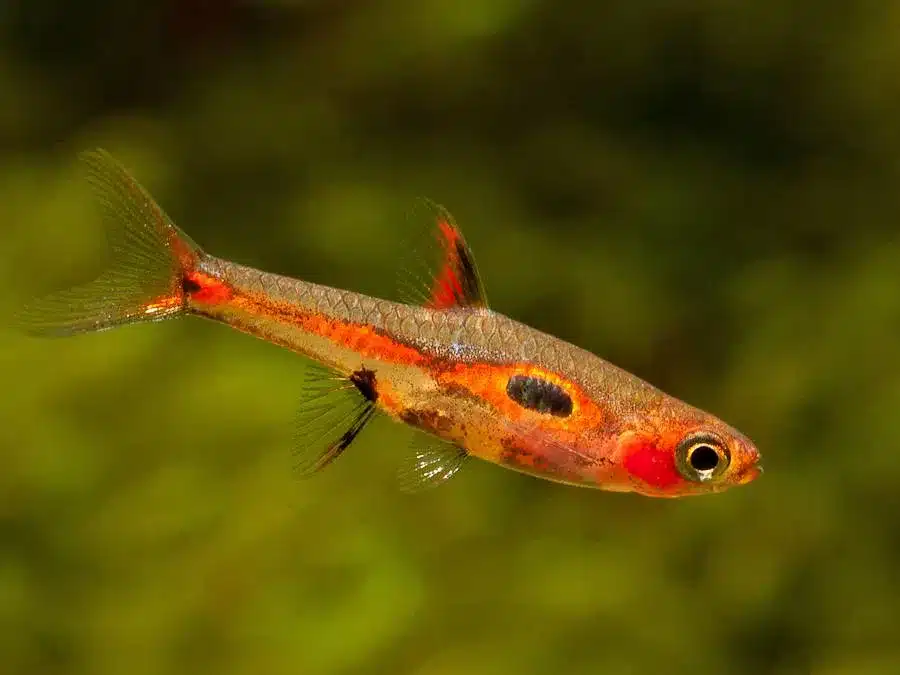
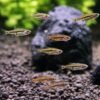
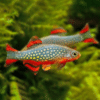
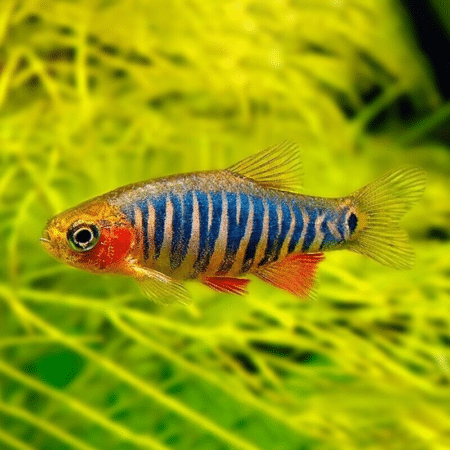
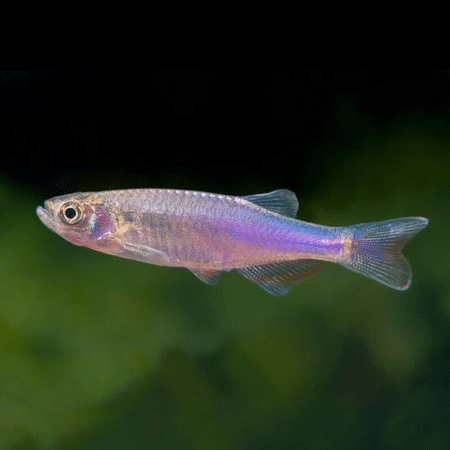
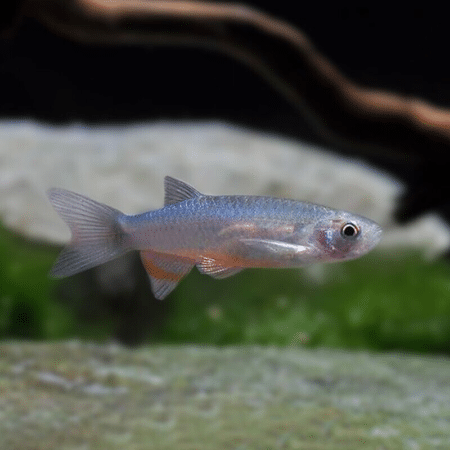
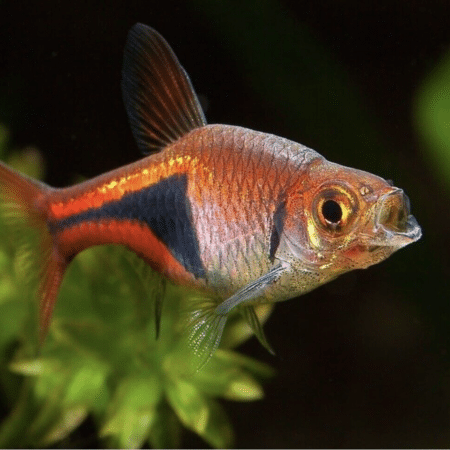


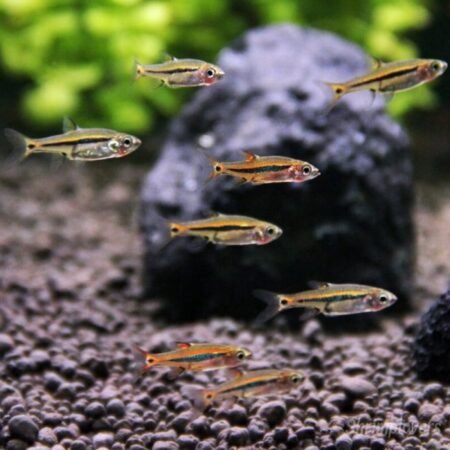




Emily Carter (verified owner) –
I recently added 6 X Rasbora maculata, and I couldn’t be happier! These little Dwarf Rasboras are not only adorable but also incredibly active and social. I’ve had them for about two months now, and they’ve truly brought my tank to life. They swim around in a charming school, often mingling with my betta fish and neon tetras without any issues. It’s heartwarming to see them darting playfully among the plants in my 20-gallon tank.
One of the standout features of these fish is their peaceful nature. I’ve kept danios in the past that were a bit nippy, but these sweet rasboras are so gentle. They thrive in a planted tank with ample hiding spots, which makes it a perfect environment for them. Just be sure to keep your water conditions stable; they do best when the temperature is kept around 76-80°F.
The shipping was fast, and they arrived in perfect health, which is always a relief. I highly recommend these little gems to anyone looking to add some lively personality to their aquarium. They’re perfect for community tanks or even as a centerpiece for smaller setups. Just be prepared to smile at their antics every day!
Emily Carter (verified owner) –
I recently added 6 Dwarf Rasboras to my nano tank, and I couldn’t be happier! These little guys are not only stunning with their vibrant colors, but they also bring such a lively energy to my aquarium. Within just a week, I noticed them schooling beautifully, creating a peaceful yet dynamic environment that I adore. Compared to my previous neon tetras, the Dwarf Rasboras are more active and seem to get along better with my bettas, which was a pleasant surprise. I’ve been careful to maintain parameters suitable for all my freshwater fish, and these Rasboras have thrived without any signs of stress or aggression. If you’re a caring fish parent like me, you’ll appreciate how gentle they are with each other. Just a minor note: they can be a bit shy at first, so providing plenty of hiding spots is key. Overall, I highly recommend Dwarf Rasboras for anyone looking to create a harmonious and visually stunning schooling fish environment. They truly are a joy to watch!